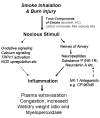Substance P antagonist CP-96345 blocks lung vascular leakage and inflammation more effectively than its stereoisomer CP-96344 in a mouse model of smoke inhalation and burn injury
- PMID: 20201741
- PMCID: PMC2859096
- DOI: 10.3109/15376511003674657
Substance P antagonist CP-96345 blocks lung vascular leakage and inflammation more effectively than its stereoisomer CP-96344 in a mouse model of smoke inhalation and burn injury
Abstract
The recently developed murine model of smoke inhalation and burn (SB) injury was used to study the effect of the substance-P antagonist CP96345. C57BL/6 mice were pre-treated with an i.v. dose of a specific NK-1 receptor antagonist, CP9635, or its inactive enantiomer, CP96344, (10 mg/Kg) 1 h prior to SB injury per protocol (n = 5). Mice were anesthetized and exposed to cooled cotton smoke, 2X 30 s, followed by a 40% total body surface area flame burn per protocol. At 48 h after SB injury Evans Blue (EB) dye and myeloperoxidase (MPO) were measured in lung after vascular perfusion. Lungs were also analyzed for hemoglobin (Hb) and wet/dry weight ratio. In the current study, CP96345 pre-treatment caused a significant decrease in wet/dry weight ratio (23%, p = 0.048), EB (31%, p = 0.047), Hb (46%, p = 0.002), and MPO (54%, p = 0.037) levels following SB injury compared to animals with SB injury alone. CP-96344 pre-treatment caused an insignificant decrease in wet/dry weight ratio (14%, p = 0.18), EB (16%, p = 0.134), Hb (9%, p = 0.39), and an insignificant increase in MPO (4%, p = 0.79) as compared to mice that received SB injury alone. As expected, levels of EB, Hb, MPO, and wet/dry weight ratios were all significantly (p < 0.05) increased 48 h following SB injury alone compared to respective sham animals. In conclusion, the current study indicates that pre-treatment with a specific NK-1R antagonist CP-96345 attenuates the lung injury and inflammation induced by SB injury in mice.
Figures





Similar articles
-
Mechanisms of toxic smoke inhalation and burn injury: role of neutral endopeptidase and vascular leakage in mice.Toxicol Mech Methods. 2009 Mar;19(3):191-6. doi: 10.1080/15376510902725649. Toxicol Mech Methods. 2009. PMID: 19727335 Free PMC article.
-
Assessment of lung inflammation in a mouse model of smoke inhalation and burn injury: strain-specific differences.Toxicol Mech Methods. 2008 Jan;18(7):551-9. doi: 10.1080/15376510802251993. Toxicol Mech Methods. 2008. PMID: 20020853
-
Substance P acts via the neurokinin receptor 1 to elicit bronchoconstriction, oxidative stress, and upregulated ICAM-1 expression after oil smoke exposure.Am J Physiol Lung Cell Mol Physiol. 2008 May;294(5):L912-20. doi: 10.1152/ajplung.00443.2007. Epub 2008 Mar 7. Am J Physiol Lung Cell Mol Physiol. 2008. PMID: 18326823
-
Indices of antioxidant status in rats subjected to wood smoke inhalation and/or thermal injury.Toxicology. 2002 Jul 1;176(1-2):145-57. doi: 10.1016/s0300-483x(02)00132-4. Toxicology. 2002. PMID: 12062938
-
Role of substance P in hydrogen sulfide-induced pulmonary inflammation in mice.Am J Physiol Lung Cell Mol Physiol. 2006 Nov;291(5):L896-904. doi: 10.1152/ajplung.00053.2006. Epub 2006 Jun 23. Am J Physiol Lung Cell Mol Physiol. 2006. PMID: 16798781
Cited by
-
Aerosol inhalation of edaravone can improve inflammation, oxidative stress and pulmonary function of rats with smoke inhalation injury by down-regulating miR-320.Am J Transl Res. 2021 Apr 15;13(4):2563-2570. eCollection 2021. Am J Transl Res. 2021. PMID: 34017415 Free PMC article.
-
Tachykinin-1 receptor antagonism suppresses substance-P- and compound 48/80-induced mast cell activation from rat mast cells expressing functional mas-related GPCR B3.Inflamm Res. 2020 Mar;69(3):289-298. doi: 10.1007/s00011-020-01319-z. Epub 2020 Jan 28. Inflamm Res. 2020. PMID: 31993675
-
Inflammation and Organ Injury the Role of Substance P and Its Receptors.Int J Mol Sci. 2023 Mar 24;24(7):6140. doi: 10.3390/ijms24076140. Int J Mol Sci. 2023. PMID: 37047113 Free PMC article. Review.
-
Impacts from Wildfires on Livestock Health and Production: Producer Perspectives.Animals (Basel). 2021 Nov 12;11(11):3230. doi: 10.3390/ani11113230. Animals (Basel). 2021. PMID: 34827962 Free PMC article.
References
-
- Alarie Y, Stock MF, Matijak-Schaper M, Birky MM. Toxicity of smoke during chair smoldering tests and small scale tests using the same materials. Fundam Appl Toxicol. 1983;3(6):619–26. - PubMed
-
- Alarie Y. The toxicity of smoke from polymeric materials during thermal Decomposition. Annu Rev Pharmacol Toxicol. 1985;25:325–47. - PubMed
-
- Barnes PJ. Role of neural mechanisms in airway defense. In: Chretien J, Dusser D, editors. Environmental Impact in the Airways. Marcel Dekker; New York: 1996. pp. 93–121.
-
- Barrow RE, Morris SE, Basadre JO, Herndon DN. Selective permeability changes in the lungs and airways of sheep after toxic smoke inhalation. J Appl Physiol. 1990;68:2165–2170. - PubMed
-
- Bidani A, Hawkins HK, Wang CZ, Heming TA. Dose dependence and time course of smoke inhalation injury in a rabbit model. Lung. 1999;177:111–122. - PubMed
Publication types
MeSH terms
Substances
Grants and funding
LinkOut - more resources
Full Text Sources
Research Materials
Miscellaneous
